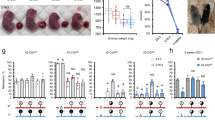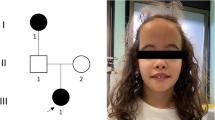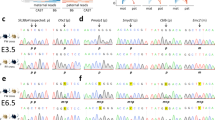Abstract
In mice and humans, the locus encoding the gene for small nuclear ribonucleoprotein N (SNRPN/Snrpn), as well as other loci in the region are subject to genomic imprinting. The SNRPN promoter is embedded in a maternally methylated CpG island, is expressed only from the paternal chromosome and lies within an imprinting center that is required for switching to and/or maintenance of the paternal epigenotype. We show here that a 0.9-kb deletion of exon 1 of mouse Snrpn did not disrupt imprinting or elicit any obvious phenotype, although it did allow the detection of previously unknown upstream exons. In contrast, a larger, overlapping 4.8-kb deletion caused a partial or mosaic imprinting defect and perinatal lethality when paternally inherited.
This is a preview of subscription content, access via your institution
Access options
Subscribe to this journal
Receive 12 print issues and online access
$209.00 per year
only $17.42 per issue
Buy this article
- Purchase on Springer Link
- Instant access to full article PDF
Prices may be subject to local taxes which are calculated during checkout




Similar content being viewed by others
References
Nicholls, R.D., Saitoh, S. & Horsthemke, B. Imprinting in Prader-Willi and Angelman syndromes. Trends Genet. 14, 194–200 (1998).
Jiang, Y., Tsai, T.-F., Bressler, J. & Beaudet, A.L. Imprinting in Angelman and Prader- Willi syndromes. Curr. Opin. Genet. Dev. 8, 334–342 (1998).
Mann, M.R. & Bartolomei, M.S. Towards a molecular understanding of Prader-Willi and Angelman syndromes. Hum. Mol. Genet. 8, 1867–1873 (1999).
Schulze, A. et al. Exclusion of SNRPN as a major determinant of Prader-Willi syndrome by a translocation breakpoint. Nature Genet. 12, 452–454 (1996).
Sun, Y. et al. Breakage in the SNRPN locus in a balanced 46,XY,t(15;19) Prader-Willi syndrome patient. Hum. Mol. Genet. 5, 517–524 (1996).
Conroy, J.M. et al. Balanced translocation 46,XY,t(2;15)(q37.2;q11.2) associated with atypical Prader-Willi syndrome. Am. J. Hum. Genet. 61, 388–394 (1997).
Kuslich, C.D., Kobori, J.A., Mohapatra, G., Gregorio-King, C. & Donlon, T. A. Prader- Willi syndrome is caused by disruption of the SNRPN gene. Am. J. Hum. Genet. 64, 70–76 (1999).
Gray, T.A., Saitoh, S. & Nicholls, R D. An imprinted, mammalian bicistronic transcript encodes two independent proteins. Proc. Natl. Acad. Sci. USA 96, 5616–5621 (1999).
Blaydes, S.M., Elmore, M., Yang, T. & Brannan, C.I. Analysis of murine Snrpn and human SNRPN gene imprinting in transgenic mice. Mamm. Genome 10, 549–555 (1999).
Sutcliffe, J.S. et al. Deletions of a differentially methylated CpG island at the SNRPN gene define a putative imprinting control region. Nature Genet. 8, 52–58 (1994).
Glenn, C.C. et al. Gene structure, DNA methylation, and imprinted expression of the human SNRPN gene. Am. J. Hum. Genet. 58, 335–346 (1996).
Shemer, R., Birger, Y., Riggs, A.D. & Razin, A. Structure of the imprinted mouse Snrpn gene and establishment of its parental-specific methylation pattern. Proc. Natl. Acad. Sci. USA 94, 10267–10272 (1997).
Gabriel, J.M. et al. Structure and function correlations at the imprinted mouse Snrpn locus. Mamm. Genome 9, 788–793 (1998).
Buiting, K. et al. Inherited microdeletions in the Angelman and Prader-Willi syndromes define an imprinting centre on human chromosome 15. Nature Genet. 9, 395–400 (1995).
Dittrich, B. et al. Imprint switching on human chromosome 15 may involve alternative transcripts of the SNRPN gene. Nature Genet. 14, 163–170 (1996).
Saitoh, S. et al. Minimal definition of the imprinting center and fixation of a chromosome 15q11-q13 epigenotype by imprinting mutations. Proc. Natl. Acad. Sci. USA 93, 7811–7815 (1996).
Buiting, K., Lich, C., Cottrell, S., Barnicoat, A. & Horsthemke, B. A 5-kb imprinting center deletion in a family with Angelman syndrome reduces the shortest region of deletion overlap to 880 bp. Hum. Genet. 105, 665–666 (1999).
Ohta, T. et al. Imprinting-mutation mechanisms in Prader-Willi syndrome. Am. J. Hum. Genet. 64, 397–413 (1999).
Reis, A. et al. Imprinting mutations suggested by abnormal DNA methylation patterns in familial Angelman and Prader-Willi syndromes. Am. J. Hum. Genet. 54, 741–747 (1994).
Buiting, K. et al. Sporadic imprinting defects in Prader-Willi syndrome and Angelman syndrome: Implications for imprint-switch models, genetic counseling, and prenatal diagnosis. Am. J. Hum. Genet. 63, 170–180 (1998).
Ferguson-Smith, A.C. Imprinting moves to the centre. Nature Genet. 14, 119–121 (1996).
Brannan, C.I. & Bartolomei, M.S. Mechanisms of genomic imprinting. Curr. Opin. Genet. Dev. 9, 164–170 (1999).
Shemer, R. et al. The imprinting box of the Prader-Willi/Angelman syndrome domain. Nature Genet. 26, 440–443 (2000).
Tilghman, S.M., Caspary, T. & Ingram, R.S. Competitive edge at the imprinted Prader-Willi/Angelman region? Nature Genet. 18, 206–208 (1998).
Bielinska, B. et al. De novo deletions of SNRPN exon 1 in early human and mouse embryos result in a paternal to maternal imprint switch. Nature Genet. 25, 74–78 (2000).
Yang, T. et al. A mouse model for Prader-Willi syndrome imprinting-centre mutations. Nature Genet. 19, 25–31 (1998).
Huq, A.H.M.M. et al. Sequencing and functional analysis of the SNRPN promoter: In vitro methylation abolishes promoter activity. Genome Res. 7, 642–648 (1997).
Mutirangura, A. et al. A complete yeast artificial chromosome (YAC) contig of the Prader-Willi/Angelman syndrome (PWS/AS) region and refined localization of the SNRPN gene. Genomics 18, 546 (1993).
Watrin, F. et al. The mouse necdin gene is expressed from the paternal allele only and lies in the 7C region of the mouse chromosome 7, a region of conserved synteny to the human Prader-Willi syndrome region. Eur. J. Hum. Genet. 5, 324–332 (1997).
Tsai, T.F., Jiang, Y.H., Bressler, J., Armstrong, D. & Beaudet, A.L. Paternal deletion from Snrpn to Ube3a in the mouse causes hypotonia, growth retardation and partial lethality and provides evidence for a gene contributing to Prader-Willi syndrome. Hum. Mol. Genet. 8, 1357–1364 (1999).
Farber, C., Dittrich, B., Buiting, K. & Horsthemke, B. The chromosome 15 imprinting centre (IC) region has undergone multiple duplication events and contains an upstream exon of SNRPN that is deleted in all Angelman syndrome patients with an IC microdeletion. Hum. Mol. Genet. 8, 337–343 (1999).
Gillessen-Kaesbach, G. et al. A previously unrecognised phenotype characterised by obesity, muscular hypotonia, and ability to speak in patients with Angelman syndrome caused by an imprinting defect. Eur. J. Hum. Genet. 7, 638–644 (1999).
Wolff, G.L., Kodell, R.L., Moore, S.R. & Cooney, C.A. Maternal epigenetics and methyl supplements affect agouti gene expression in Avy/a mice. FASEB J. 12, 949–957 (1998).
Cattanach, B. M. et al. A candidate mouse model for Prader-Willi syndrome which shows an absence of Snrpn expression. Nature Genet. 2, 270–274 (1992).
Gabriel, J.M. et al. A transgene insertion creating a heritable chromosome deletion mouse model of Prader-Willi and Angelman syndromes. Proc. Natl. Acad. Sci. USA 96, 9258–9263 (1999).
El Maarri, O. et al. Maternal methylation imprints on human chromosome 15 are established during or after fertilization. Nature Genet. 27, 341–344 (2001).
de Los, S.T., Schweizer, J., Rees, C.A. & Francke, U. Small evolutionarily conserved RNA, resembling C/D box small nucleolar RNA, is transcribed from PWCR1, a novel imprinted gene in the Prader-Willi deletion region, which is highly expressed in brain. Am. J. Hum. Genet. 67, 1067–1082 (2000).
Cavaille, J. et al. From the Cover: Identification of brain-specific and imprinted small nucleolar RNA genes exhibiting an unusual genomic organization. Proc. Natl. Acad. Sci. USA 97, 14311–14316 (2000).
Tsai, T.-F., Armstrong, D. & Beaudet, A.L. Necdin deficient mice do not show lethality or the obesity and infertility of Prader-Willi syndrome. Nature Genet. 22, 15–16 (1999).
Gerard, M., Hernandez, L., Wevrick, R. & Stewart, C.L. Disruption of the mouse necdin gene results in early post-natal lethality. Nature Genet. 23, 199–202 (1999).
Muscatelli, F. et al. Disruption of the mouse necdin gene results in hypothalamic and behavioral alterations reminiscent of the human Prader-Willi syndrome. Hum. Mol. Genet. 9, 3101–3110 (2000).
Simpson, E.M. et al. Genetic variation among 129 substrains and its importance for targeted mutagenesis in mice. Nature Genet. 16, 19–27 (1997).
Southern, E.M. Detection of specific sequences among DNA fragments separated by gel electrophoresis. J. Mol. Biol. 98, 503 (1975).
Sambrook, J., Fritsch, E.F. & Maniatis, T. in Molecular Cloning. A Laboratory Manual (Cold Spring Harbor Laboratory, Cold Spring Harbor, New York, 1989).
Feinberg, A.P. & Vogelstein, B. A technique for radiolabeling DNA restriction endonuclease fragments to high specific activity. Anal. Biochem. 132, 6–13 (1983).
Wevrick, R. & Francke, U. An imprinted mouse transcript homologous to the human imprinted in Prader-Willi syndrome (IPW) gene. Hum. Mol. Genet. 6, 325–332 (1997).
MacDonald, H.R. & Wevrick, R. The necdin gene is deleted in Prader-Willi syndrome and is imprinted in human and mouse. Hum. Mol. Genet. 6, 1873–1878 (1997).
Abuin, A. & Bradley, A. Recycling selectable markers in mouse embryonic stem cells. Mol. Cell. Biol. 16, 1851–1856 (1996).
Ramirez-Solis, R., Davis, A.C. & Bradley, A. Gene targeting in embryonic stem cells. Methods Enzymol. 225, 855 (1993).
Acknowledgements
We thank R. Sierra for technical assistance and Y.-h. Jiang for discussions. We thank B. Horsthemke for communications and sharing information before publication. J.B. thanks T-F. T., without whose support and contributions, this work would not have been possible. This work was supported by US National Institutes of Health grant HD-37283 and Taiwan NSC89-2320-B-D10-044.
Author information
Authors and Affiliations
Corresponding author
Rights and permissions
About this article
Cite this article
Bressler, J., Tsai, TF., Wu, MY. et al. The SNRPN promoter is not required for genomic imprinting of the Prader-Willi/Angelman domain in mice. Nat Genet 28, 232–240 (2001). https://doi.org/10.1038/90067
Received:
Accepted:
Issue Date:
DOI: https://doi.org/10.1038/90067
This article is cited by
-
Application of droplet digital PCR in the analysis of genome integration and organization of the transgene in BAC transgenic mice
Scientific Reports (2018)
-
Genomic imprinting does not reduce the dosage of UBE3A in neurons
Epigenetics & Chromatin (2017)
-
Maternal vitamin D depletion alters DNA methylation at imprinted loci in multiple generations
Clinical Epigenetics (2016)
-
Maternal transcription of non-protein coding RNAs from the PWS-critical region rescues growth retardation in mice
Scientific Reports (2016)
-
Protein Delivery of an Artificial Transcription Factor Restores Widespread Ube3a Expression in an Angelman Syndrome Mouse Brain
Molecular Therapy (2016)



